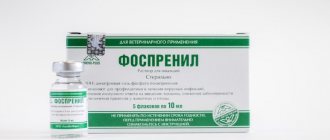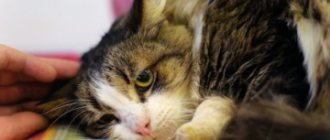In veterinary medicine, the pharmaceutical drug “Clamoxil” is actively used for cats. It is a semi-synthetic penicillin antibiotic with a wide range of action. "Clamoxil" is highly effective and fast-acting. It can be used to treat cats only with the permission of a veterinarian, who will examine the furry patient, make a diagnosis and, after assessing the severity of the animal’s condition, prescribe the necessary dosages.
Composition and storage conditions
Clamoxil belongs to the group of antibacterial agents. The main active ingredient is amoxicillin. Additionally included:
- aluminum stearate;
- Coconut oil.
These auxiliary components are necessary for the medicine to acquire the consistency of a suspension. The drug can be stored at a temperature not exceeding +25ºC, in a dark place inaccessible to children.
After opening the bottle, you can use the medicine for 1 month. If unopened, the packaging can be stored for 3 years. After the expiration date, the medicine cannot be used. It must be disposed of.
Instructions for use
Dosage
The dose required for treatment depends on the weight of the animal. For every 10 kg of mass, 1 ml of the substance is taken. If the cat weighs less than 1 kg, 0.5 ml of the drug is drawn into the syringe.
There are 2 ways to calculate a single dose of medication. 150 mg of the active substance is contained in 1 ml of the drug, and 1 kg of weight should contain 15 mg of the drug. But most often, veterinarians select the dosage individually, taking into account the condition of the animal.
For a common cold, Clamoxil is administered once. If there are complications, the injection is repeated after 48 hours. If the animal’s condition does not improve within 2 days, it is necessary to show the pet to a veterinarian, because... The bacteria may be resistant to amoxicillin.
A specialist must conduct treatment and select a therapeutic dose of medication. The suspension is effective for 48 hours. In some cases, Clamoxil can be used in the postoperative period to prevent complications.
How to inject?
To treat animals, the suspension is administered subcutaneously or intramuscularly . It is advisable to have the injection performed by a specialist. It is more convenient to administer the medicine with an assistant: one person fixes the animal, the second gives the injection.
Clamoxil is administered slowly to minimize pain for the animal. The drug is injected into the withers or thigh area. When making an injection, the needle is inserted to a depth of ⅓ of its length. The puncture site is pre-treated with a disinfectant.
For a subcutaneous injection, the needle is inserted at a 45º angle towards the animal's spine. The rules of introduction are the same, slowly and in a stream.
In what cases is the drug prescribed?
The medication is used for food poisoning in cats, as well as in the presence of bacterial diarrhea. The drug is effective against inflammation of the lungs and bronchi, and has a detrimental effect on bacteria that cause cystitis. The medicine is prescribed to eliminate purulent lesions of the skin and mucous membranes, as well as to prevent postoperative complications in pets.
Penicillin antibiotics are prescribed in combination with other drugs to eliminate abscesses and other infectious complications in cats.
Side effects
Among the adverse reactions when using Clamoxil, the most common is allergies. In some cases, the beneficial intestinal microflora may be disrupted, and then the animal develops symptoms of an intestinal disorder, accompanied by diarrhea. Pets may have:
- Loss of appetite.
- Nausea and vomiting.
- Increased salivation.
- Lethargy.
If such signs are detected, it is necessary to stop treatment and contact a veterinarian, but only if they do not disappear for a long time.
This type of antibiotic is not used in the treatment of old and severely weakened animals. Since the drug is excreted in the urine, it is not recommended for use in pets with kidney problems. The medication cannot be used in conjunction with other antibiotics.
Negative phenomena
An allergic reaction to the drug may result in severe itching in the animal.
If you strictly follow the veterinarian's recommendations and the manufacturer's instructions, the chance of developing side symptoms is minimal. In exceptional cases, during treatment with Clamoxil, signs of allergy may occur, manifested in the form of redness of the skin, especially at the injection site, swelling and itching. In addition, when studying the medicine, it was noticed that cats with an allergy to it may experience baldness, anaphylactic shock and difficulty breathing. If such negative effects develop, you should stop therapy and consult a veterinarian to find a replacement for Clamoxyl.
Pregnant, lactating and kittens
The drug is not recommended for the treatment of pregnant animals, especially if there is very little time left before birth. The antibiotic negatively affects future offspring. An exception is made for those females who are in poor condition. In this case we are talking about the life of an animal.
You should not give injections with this antibiotic to nursing cats. The drug is prescribed to kittens with caution in cases where the critical condition of the animal requires it. The dose is calculated only by a specialist.
Similar medical products
An absolute analogue of the Clamoxyl injection suspension is the drug Amoxicillin, which is available in the form of tablets and powder. It has a detrimental effect on various types of pathogenic microorganisms, however, there are bacteria that are resistant to the action of this antibiotic. Clamoxil also has other analogues:
The animal's condition can return to normal after Lincomycin.
- "Sinulox";
- "Gentamicin";
- "Sulf-120";
- "Sincomycin";
- "Amoxoil retard";
- "Baytril";
- "Doreen";
- "Kobaktan";
- "Stomorgil";
- "Lincomycin."
Reviews
Owners
Marina K., Sevastopol:
“I was forced to give antibiotic injections to my cat during a severe cold myself, because... There was no way to go to the vet. The first time it didn't work out very well. The suspension is thick. Then I shook the bottle, and the second time everything worked. 2 injections were enough to improve my Musya’s condition.”
Maria L., Moscow:
“My cat urgently needed help; no other drugs except Clamoxil helped. She felt better after the first injection. Despite all the concerns, there were no side effects.”
Veterinarians
Rimma V. veterinarian, Vladivostok:
“I prescribe Clamoxil quite often, especially when the animal’s condition is alarming and there are no other ways to provide help. The drug acts quickly. It has low toxicity, unlike other potent antibiotics.”
Roman S., veterinarian, Smolensk:
“Clamoxil is excellent for treating almost any bacterial infection. I had to deal with side effects no more than 2 times during my entire work.”
Contraindications
Despite the fact that Clamoxil is a safe, non-toxic veterinary drug, there are some contraindications for its use, which are indicated in the annotation.
Clamoxil is not prescribed:
- whelping bitches in the last and first trimester of pregnancy;
- animals that are intolerant to penicillin antibiotics;
- lactating bitches in the first two weeks after the birth of puppies;
- puppies up to 2-3 weeks of age.
Clamoxil is not used in the treatment of small rodents and herbivores (rabbits, hamsters, mice).
It is strictly forbidden to mix this veterinary drug in the same syringe with other medications.
It is not recommended to use bait for viral-bacterial diseases caused by bacteria that produce penicillinase.
Analogs and price
The drug can be purchased at a pharmacy or ordered on a specialized website. It is sold in 100 ml bottles. The average price of 1 bottle is 748 rubles.
Analogs of the drug are Tsiprovet, Sinulox, Sulf. Their release form is tablets, so it takes longer for them to start working. Once in the stomach, the medicine is partially destroyed by acid.
If you are individually intolerant to the components of Clamoxil, you can replace it with another medication. This product is not available in tablets.
Drugs with similar effects - table
| Name | Release form | Active ingredient | How to use | Indications | Contraindications | Price |
| Tsiprovet | Tablets and drops | Ciprofloxacin | Inside, on an empty stomach, 1 time per day. 1 tablet must be crushed and mixed with water, then given to the pet. The course of treatment is from 3 to 5 days. | Infections:
| Hypersensitivity to components | From 140 rub. |
| Sinulox | Pills | Amoxicillin+clavulanic acid | Orally, before or during meals, 2 times a day. The tablet should first be crushed and mixed with the food. Can be given forcibly with water. The course of treatment is up to 7–10 days. |
|
| From 250 rub. |
| Sulf 120 | Pills | Trimethoprim and sulfadiazine | Orally, along with food, 2 times a day. It is recommended to crush the tablet first. |
|
| From 160 rub. |
Medicines that can replace Clamoxil - photo gallery
Sinulox helps with various infectious diseases in cats and dogs
Ciprovet is active against gram-positive and gram-negative microorganisms
Sulf 120 - broad spectrum antibiotic
Clamoxil relieves your pet from inflammatory diseases caused by bacterial infections. In recommended dosages, the drug does not have a negative effect on the cat’s immune system. However, this medication should not be used without a veterinarian's prescription. It is important to first familiarize yourself with all possible contraindications.
Let's sum it up
Clamoxil can be used to treat bacterial infections of any origin. After introduction into tissues, it easily penetrates all organs and systems of the body.
The maximum concentration is achieved within 2 hours after the injection. There is a long period of time between injections, because The therapeutic effect lasts for 2 days, and there is no need to further injure the animal.
The main advantages of the product are low toxicity and high efficiency. The downside is the adverse effect on the kidneys and liver.
In some cases, in addition to pathogenic microorganisms, beneficial ones also suffer. Therefore, sometimes after treatment it is necessary to restore the intestinal flora. In terms of the degree of effect on the body, the drug is classified as a moderately dangerous compound.
Operating principle
The active component begins to act almost immediately after entering the body. Penicillins bind to pathogen membrane proteins, which are necessary to maintain its integrity. Amoxicillin acts on the rigid structure of the microbial shell, due to which it is destroyed and the bacterium becomes unviable.
When penicillin enters the body, it destroys the wall of the microbe
In the body, the active substance is distributed throughout all systems. The exception is the spinal cord, where amoxicillin enters in small quantities. The medicine is eliminated from the body very quickly through the kidneys. Therefore, if your pet has problems with the functioning of the urinary system, it is important to notify your veterinarian before starting treatment.
After administration of the drug, it acts for 18 hours. It is important to monitor your pet's response to the medication and if unwanted symptoms occur, you should notify your doctor.











